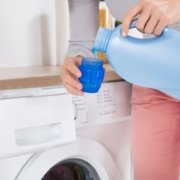Liquid Laundry Detergent
Step by step instructions for how to make laundry detergent is easy, cheap and effective in standard and HE washers. Save money and avoid harsh chemicals with this ORIGINAL recipe and procedure for liquid homemade laundry detergent. It is so good and costs less than 5 cents per load.
Servings: 34 Loads
Cost: $2
Equipment
- One-gallon container with tight fitting lid
- Measuring cup
Ingredients
- 3/4 cup super washing soda, like Arm & Hammer Super Washing Soda (Note 1)
- 3/4 cup borax, like Twenty-Mule Team Borax (Note 2)
- 3/4 cup Original Blue Dawn (Note 3)
Instructions
- Measure and pour washing soda and borax into the one-gallon container.
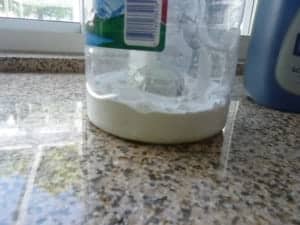
- Add 2 to 3 cups cool tap water
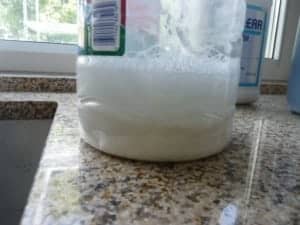
- Apply the lid and shake the container vigorously until the powdered ingredients appear to be dissolving. Give yourself a little workout here and shake it well so it looks incorporated and milky like this.
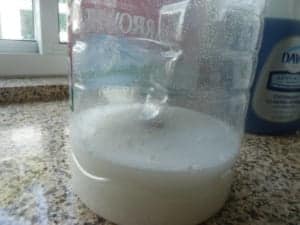
- Fill the container with tap water to within about an inch of the top, more or less depending on the shape of your container. You want to leave enough room for the Dawn which is coming up.
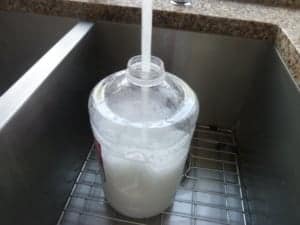
- Measure out and pour in blue Dawn dishwashing liquid. Slowly .... you don't want to create a lot of suds or bubbles.
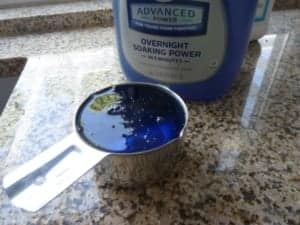
- Once you've poured in all of the Dawn, fill that measuring cup with more water so you can top off the container and rinse out the last of the Dawn. If you still have room, add more water until you are about 1/2-inch from the top.
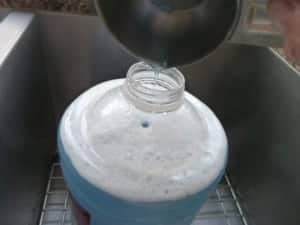
- Apply the lid. This should be quite easy because you will not be contending with suds or bubbles. Notice how the dawn is not fully mixed up. That's fine. Just get that lid on tightly.
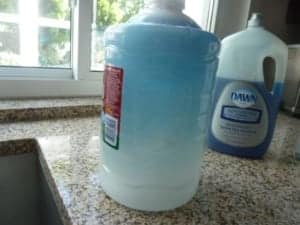
- Instead of shaking it now just put the container on its side and roll it around a bit to get everything mixed. Notice that without any kind of cleaning up at all, the counter is dry with no mess, no suds—quite clean and tidy, don't you think? Yay! We've overcome the suds-to-infinity problem so many of my readers encountered with earlier instructions.
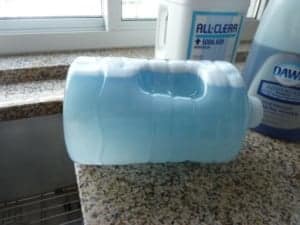
- To Use: Measure out 1 tablespoon (front loader) to 1/4 cup detergent (older top loading), more or less depending on the size and type of washer you have, and the hardness level of the water where you live. I know that sounds nebulous. Understand that you will need to experiment to find exactly the right amount for your individual conditions. If you have front-loading HE washer, start with just 1 tablespoon! That type washer uses very little water, so you want to make sure the detergent will be well rinsed out on the last rinse cycle.
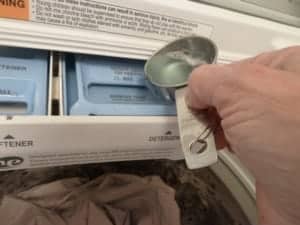
Notes
Note 1: Washing soda is the commercial name for soda ash, which is much cheaper than branded Arm & Hammer Washing Soda. Caution: Washing soda is not the same as baking soda. Washing soda is definitely not edible!
Note 2: Find it in the laundry product aisle of most supermarkets or stores like Walmart and Target.
Note 3: Blue Dawn only, please. Other colors or "brands" do not contain the proprietary formula that makes Blue Dawn a fabulous degreaser, even in this highly diluted state.
Note 4: You may notice your detergent developing "crystals" in the bottom of the container, as the detergent ages. These crystals are completely harmless, if only slightly annoying. One of the properties of borax, which is a naturally occurring mineral mined from underground, is that it clumps easily when exposed to humidity. The clumping or hardening action is hastened with heat.
Pro-tip: If you end up with a clump of crystal in the bottom of the container, whack it with the end of a wooden spoon or some other implement to break it up. Then use it up as if it were completely liquified—crystals and all. Your laundry will still come out clean and lovely. If you are still bothered by these crystals, consider making smaller batches of laundry detergent that you will up more quickly.
